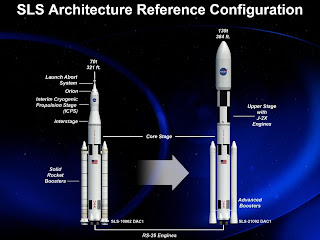SLS transportation system concepts.
Today marks an important step in NASA's plan to replace the Space Shuttle as the nation's primary space exploration vehicle. According to NASA reports, the SLS (Space Launch System) program has passed all the necessary milestones to move from the concept phase to the actual design phase. The next major milestone will be a design review later next year. Actually, spacecraft components for the system are already in material assembly and testing, such as the Orion capsule, and the core stage (Boeing) and upper stage engines. ATK in Brigham City, Utah (Yay!) is testing the solid rocket boosters ahead of time. The first test launch is scheduled for 2017.
Keep in mind that the SLS is NOT meant to replace the shuttle's use as a transportation system transferring astronauts back and forth from the International Space Station. NASA (and space exploration fans) are pinning their hopes on privatized commercial transportations systems (such as SpaceX's Dragon or ATK's Liberty) to provide that function. SLS would only be used in that purpose in the case of an emergency.
The purpose for SLS is to provide a heavier lift system to move astronauts into exploration beyond Earth's orbit. Under the Obama Administration's plans, NASA is exploring possibilities of sending astronauts to explore asteroids and prepare for future Mars exploration. The are also many who would like a return to the Moon for further exploration and development of mining opportunities.
Opinion: Overall, there is much that is similar between this design and the cancelled Constellation program design. One has to wonder at the political maneuverings that took place to cancel the Bush administration's exploration plan (admittedly underfunded and late) and the commencement of a bigger, more expensive Obama-administration design (which will no doubt end up underfunded, and late). Only time will tell. But I am pleased to see actual progress in a system that I think the nation needs for exploring anywhere beyond Low Earth Orbit.




































